Hyundai Accent 2011 Owner's Manual - RHD (UK. Australia)
Manufacturer: HYUNDAI, Model Year: 2011, Model line: Accent, Model: Hyundai Accent 2011Pages: 232, PDF Size: 8.41 MB
Page 211 of 232
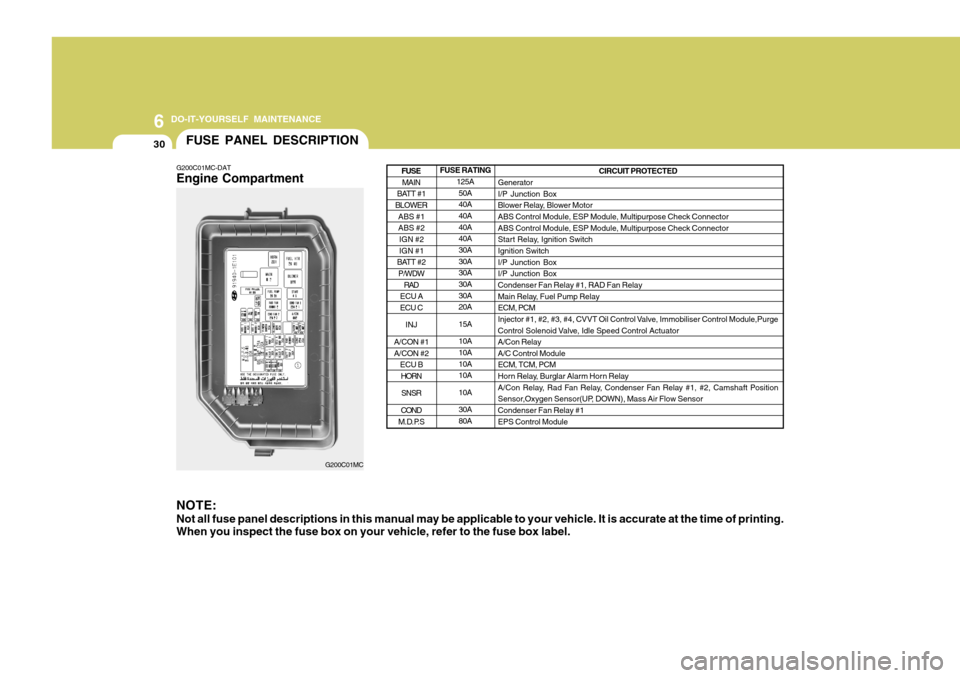
6 DO-IT-YOURSELF MAINTENANCE
30FUSE PANEL DESCRIPTION
G200C01MC-DAT Engine Compartment NOTE: Not all fuse panel descriptions in this manual may be applicable to your vehicle. It is accurate at the time of printing. When you inspect the fuse box on your vehicle, refer to the fuse box label.
G200C01MC FUSE RATING
125A50A 40A 40A 40A40A 30A 30A30A 30A 30A20A 15A10A 10A 10A10A 10A30A 80A CIRCUIT PROTECTED
GeneratorI/P Junction Box
Blower Relay, Blower MotorABS Control Module, ESP Module, Multipurpose Check Connector ABS Control Module, ESP Module, Multipurpose Check Connector
Start Relay, Ignition SwitchIgnition Switch I/P Junction Box I/P Junction BoxCondenser Fan Relay #1, RAD Fan Relay
Main Relay, Fuel Pump Relay ECM, PCM
Injector #1, #2, #3, #4, CVVT Oil Control Valve, Immobiliser Control Module,Purge
Control Solenoid Valve, Idle Speed Control Actuator A/Con RelayA/C Control ModuleECM, TCM, PCM
Horn Relay, Burglar Alarm Horn Relay
A/Con Relay, Rad Fan Relay, Condenser Fan Relay #1, #2, Camshaft Position
Sensor,Oxygen Sensor(UP, DOWN), Mass Air Flow Sensor Condenser Fan Relay #1 EPS Control Module
MAIN
BATT #1
BLOWER
ABS #1 ABS #2IGN #2 IGN #1
BATT #2 P/WDW
RAD
ECU A ECU C
INJ
A/CON #1 A/CON #2 ECU BHORN
SNSR
COND
M.D.P.S
FUSE
Page 212 of 232
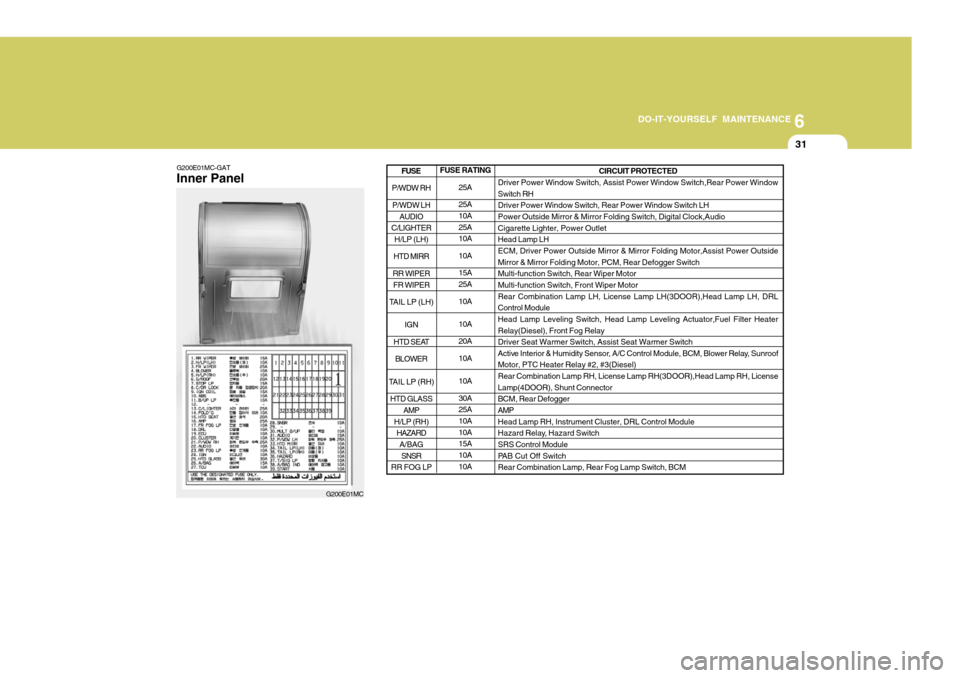
6
DO-IT-YOURSELF MAINTENANCE
31
G200E01MC-GAT Inner Panel
G200E01MCFUSE RATING
25A 25A 10A 25A10A 10A15A 25A 10A 10A 20A10A 10A 30A 25A 10A 10A15A 10A 10A CIRCUIT PROTECTED
Driver Power Window Switch, Assist Power Window Switch,Rear Power Window Switch RH Driver Power Window Switch, Rear Power Window Switch LHPower Outside Mirror & Mirror Folding Switch, Digital Clock,Audio Cigarette Lighter, Power Outlet Head Lamp LHECM, Driver Power Outside Mirror & Mirror Folding Motor,Assist Power Outside Mirror & Mirror Folding Motor, PCM, Rear Defogger Switch Multi-function Switch, Rear Wiper MotorMulti-function Switch, Front Wiper Motor Rear Combination Lamp LH, License Lamp LH(3DOOR),Head Lamp LH, DRL Control ModuleHead Lamp Leveling Switch, Head Lamp Leveling Actuator,Fuel Filter Heater Relay(Diesel), Front Fog Relay Driver Seat Warmer Switch, Assist Seat Warmer Switch
Active Interior & Humidity Sensor, A/C Control Module, BCM, Blower Relay, SunroofMotor, PTC Heater Relay #2, #3(Diesel) Rear Combination Lamp RH, License Lamp RH(3DOOR),Head Lamp RH, License Lamp(4DOOR), Shunt ConnectorBCM, Rear Defogger AMP Head Lamp RH, Instrument Cluster, DRL Control Module
Hazard Relay, Hazard Switch SRS Control Module
PAB Cut Off SwitchRear Combination Lamp, Rear Fog Lamp Switch, BCM
P/WDW RH
P/WDW LH AUDIO
C/LIGHTER H/LP (LH)
HTD MIRR
RR WIPER FR WIPER
TAIL LP (LH)
IGN
HTD SEAT BLOWER
TAIL LP (RH) HTD GLASS AMP
H/LP (RH) HAZARD
A/BAG
SNSR
RR FOG LP
FUSE
Page 213 of 232
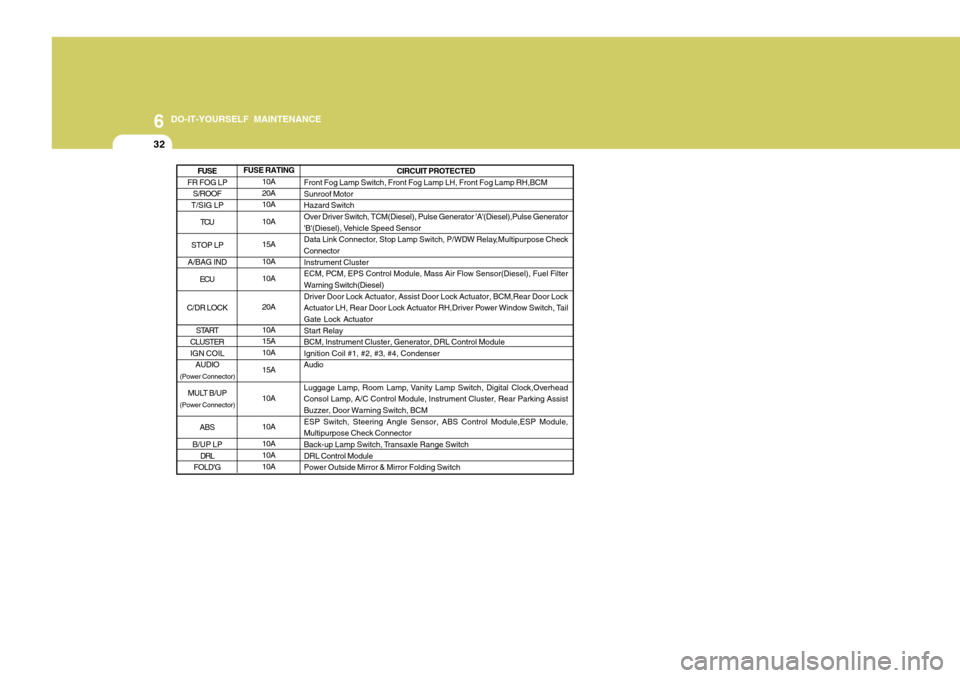
6 DO-IT-YOURSELF MAINTENANCE
32
FUSE RATING10A 20A10A 10A 15A 10A10A 20A 10A 15A 10A 15A 10A10A 10A 10A 10A CIRCUIT PROTECTED
Front Fog Lamp Switch, Front Fog Lamp LH, Front Fog Lamp RH,BCM Sunroof Motor Hazard SwitchOver Driver Switch, TCM(Diesel), Pulse Generator 'A'(Diesel),Pulse Generator
'B'(Diesel), Vehicle Speed Sensor
Data Link Connector, Stop Lamp Switch, P/WDW Relay,Multipurpose CheckConnector Instrument Cluster ECM, PCM, EPS Control Module, Mass Air Flow Sensor(Diesel), Fuel FilterWarning Switch(Diesel) Driver Door Lock Actuator, Assist Door Lock Actuator, BCM,Rear Door Lock
Actuator LH, Rear Door Lock Actuator RH,Driver Power Window Switch, TailGate Lock Actuator Start Relay BCM, Instrument Cluster, Generator, DRL Control ModuleIgnition Coil #1, #2, #3, #4, CondenserAudio
Luggage Lamp, Room Lamp, Vanity Lamp Switch, Digital Clock,Overhead Consol Lamp, A/C Control Module, Instrument Cluster, Rear Parking Assist Buzzer, Door Warning Switch, BCM ESP Switch, Steering Angle Sensor, ABS Control Module,ESP Module,Multipurpose Check Connector
Back-up Lamp Switch, Transaxle Range Switch DRL Control ModulePower Outside Mirror & Mirror Folding Switch
FR FOG LP S/ROOF
T/SIG LP
TCU
STOP LP
A/BAG IND ECU
C/DR LOCK START
CLUSTER IGN COIL AUDIO
(Power Connector)
MULT B/UP
(Power Connector)
ABS
B/UP LP DRL
FOLD'G
FUSE
Page 214 of 232
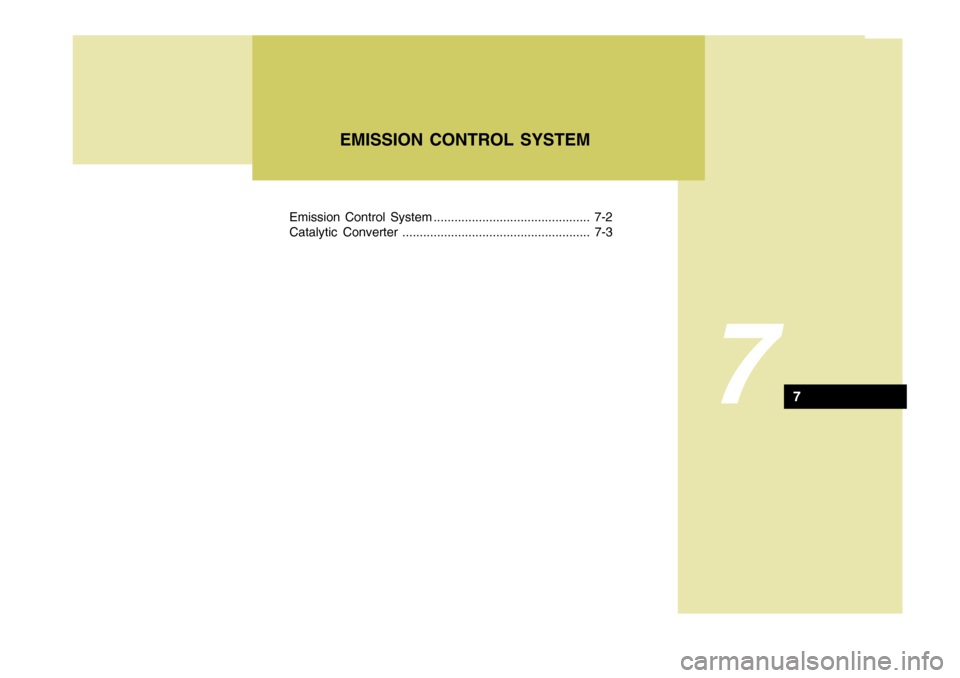
Emission Control System ............................................. 7-2
Catalytic Converter ...................................................... 7-3
7
EMISSION CONTROL SYSTEM
7
Page 215 of 232
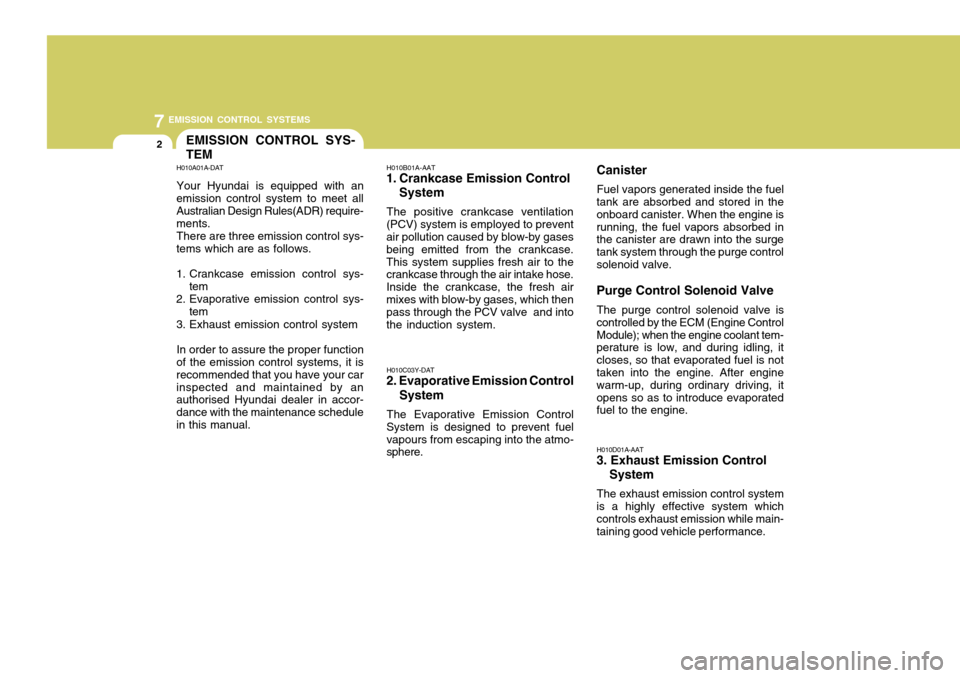
7EMISSION CONTROL SYSTEMS
2EMISSION CONTROL SYS- TEM
H010A01A-DAT Your Hyundai is equipped with an
emission control system to meet all Australian Design Rules(ADR) require- ments.
There are three emission control sys-
tems which are as follows.
1. Crankcase emission control sys-
tem
2. Evaporative emission control sys-
tem
3. Exhaust emission control system
In order to assure the proper function
of the emission control systems, it is recommended that you have your carinspected and maintained by an authorised Hyundai dealer in accor- dance with the maintenance schedulein this manual. H010B01A-AAT
1. Crankcase Emission Control
System
The positive crankcase ventilation
(PCV) system is employed to prevent air pollution caused by blow-by gases being emitted from the crankcase.This system supplies fresh air to the crankcase through the air intake hose. Inside the crankcase, the fresh airmixes with blow-by gases, which then pass through the PCV valve and into the induction system.
H010C03Y-DAT
2. Evaporative Emission Control
System
The Evaporative Emission Control
System is designed to prevent fuelvapours from escaping into the atmo- sphere. H010D01A-AAT
3. Exhaust Emission Control
System
The exhaust emission control system
is a highly effective system whichcontrols exhaust emission while main- taining good vehicle performance.
Canister
Fuel vapors generated inside the fuel
tank are absorbed and stored in theonboard canister. When the engine isrunning, the fuel vapors absorbed in the canister are drawn into the surge tank system through the purge controlsolenoid valve. Purge Control Solenoid Valve
The purge control solenoid valve is
controlled by the ECM (Engine Control Module); when the engine coolant tem- perature is low, and during idling, it closes, so that evaporated fuel is not taken into the engine. After engine warm-up, during ordinary driving, itopens so as to introduce evaporated fuel to the engine.
Page 216 of 232
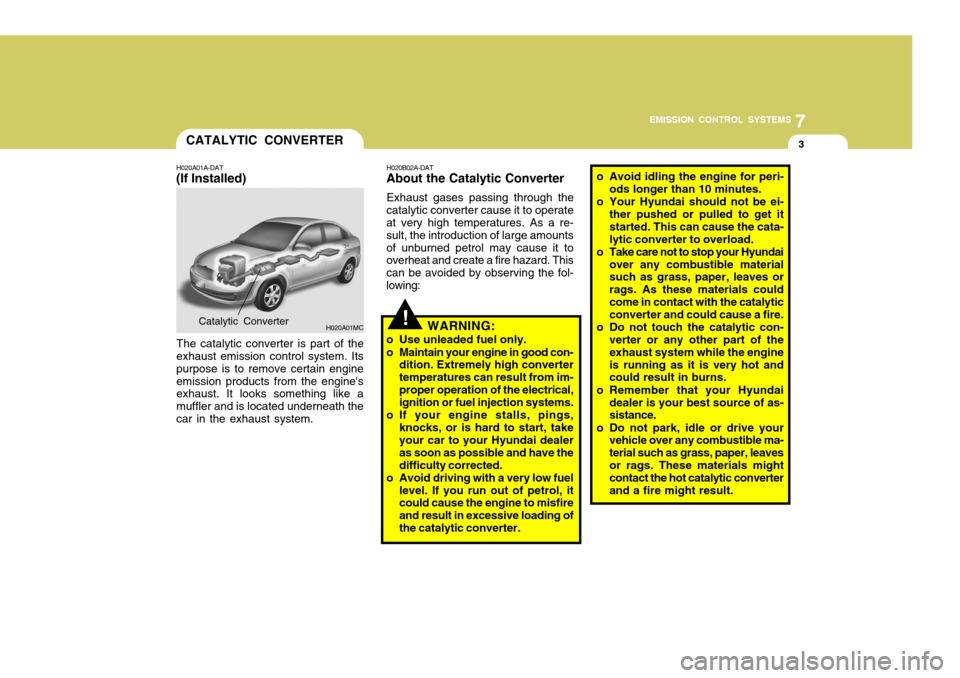
7
EMISSION CONTROL SYSTEMS
3CATALYTIC CONVERTER
H020A01A-DAT
(If Installed)
The catalytic converter is part of the
exhaust emission control system. Its purpose is to remove certain engineemission products from the engine's exhaust. It looks something like a muffler and is located underneath thecar in the exhaust system. H020B02A-DAT
About the Catalytic Converter
Exhaust gases passing through the
catalytic converter cause it to operate at very high temperatures. As a re- sult, the introduction of large amountsof unburned petrol may cause it to overheat and create a fire hazard. This can be avoided by observing the fol-lowing:
H020A01MCCatalytic Converter!WARNING:
o Use unleaded fuel only.
o Maintain your engine in good con- dition. Extremely high converter temperatures can result from im-proper operation of the electrical, ignition or fuel injection systems.
o If your engine stalls, pings, knocks, or is hard to start, takeyour car to your Hyundai dealer as soon as possible and have thedifficulty corrected.
o Avoid driving with a very low fuel
level. If you run out of petrol, it could cause the engine to misfire and result in excessive loading ofthe catalytic converter. o Avoid idling the engine for peri-
ods longer than 10 minutes.
o Your Hyundai should not be ei- ther pushed or pulled to get itstarted. This can cause the cata-lytic converter to overload.
o Take care not to stop your Hyundai over any combustible material such as grass, paper, leaves or rags. As these materials couldcome in contact with the catalytic converter and could cause a fire.
o Do not touch the catalytic con- verter or any other part of the exhaust system while the engineis running as it is very hot and could result in burns.
o Remember that your Hyundai dealer is your best source of as-sistance.
o Do not park, idle or drive your vehicle over any combustible ma- terial such as grass, paper, leavesor rags. These materials might contact the hot catalytic converter and a fire might result.
Page 217 of 232
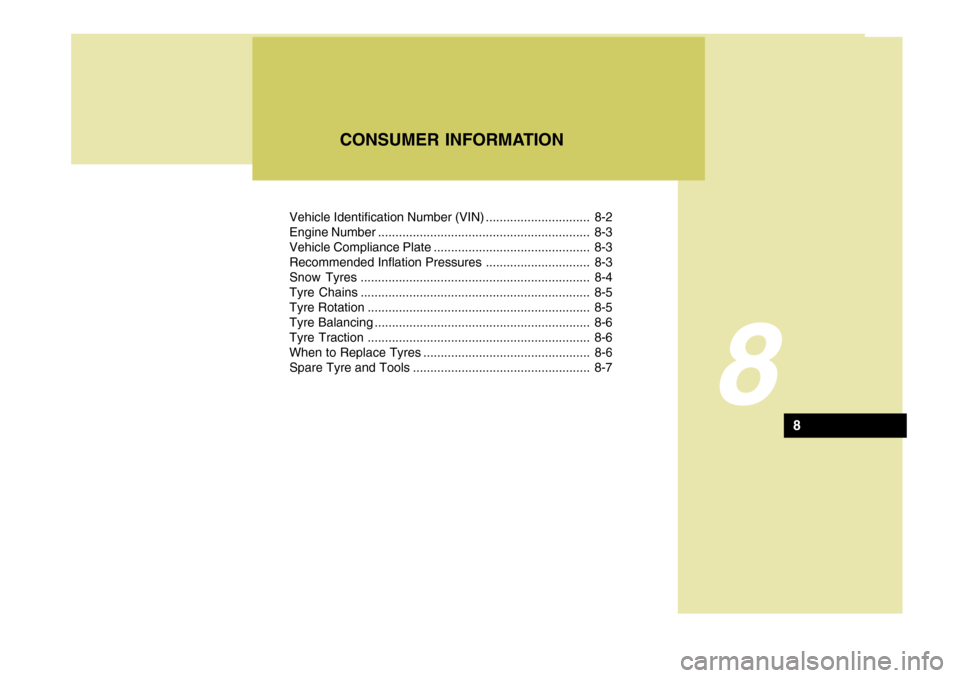
Vehicle Identification Number (VIN) .............................. 8-2
Engine Number ............................................................. 8-3
Vehicle Compliance Plate ............................................. 8-3
Recommended Inflation Pressures .............................. 8-3
Snow Tyres .................................................................. 8-4
Tyre Chains .................................................................. 8-5
Tyre Rotation ................................................................ 8-5
Tyre Balancing .............................................................. 8-6
Tyre Traction ................................................................ 8-6
When to Replace Tyres ................................................ 8-6
Spare Tyre and Tools ................................................... 8-7
8
CONSUMER INFORMATION
8
Page 218 of 232
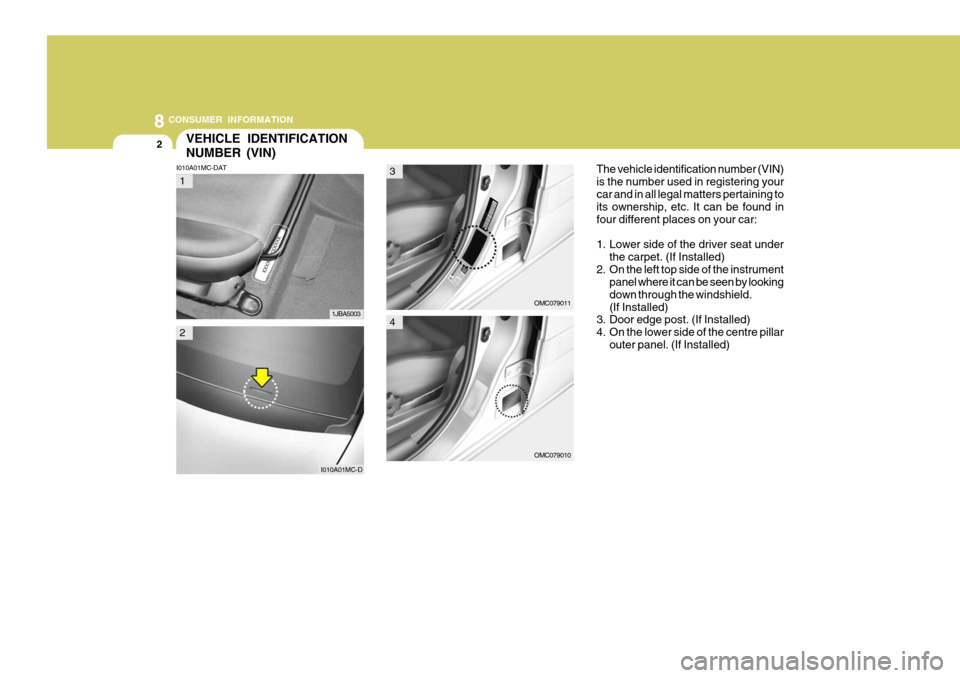
8CONSUMER INFORMATION
2VEHICLE IDENTIFICATION NUMBER (VIN)
I010A01MC-DAT The vehicle identification number (VIN) is the number used in registering yourcar and in all legal matters pertaining to its ownership, etc. It can be found in four different places on your car:
1. Lower side of the driver seat under
the carpet. (If Installed)
2. On the left top side of the instrument panel where it can be seen by looking down through the windshield.(If Installed)
3. Door edge post. (If Installed)
4. On the lower side of the centre pillar
outer panel. (If Installed)
OMC079010
OMC079011
1
2
3
41JBA5003
I010A01MC-D
Page 219 of 232
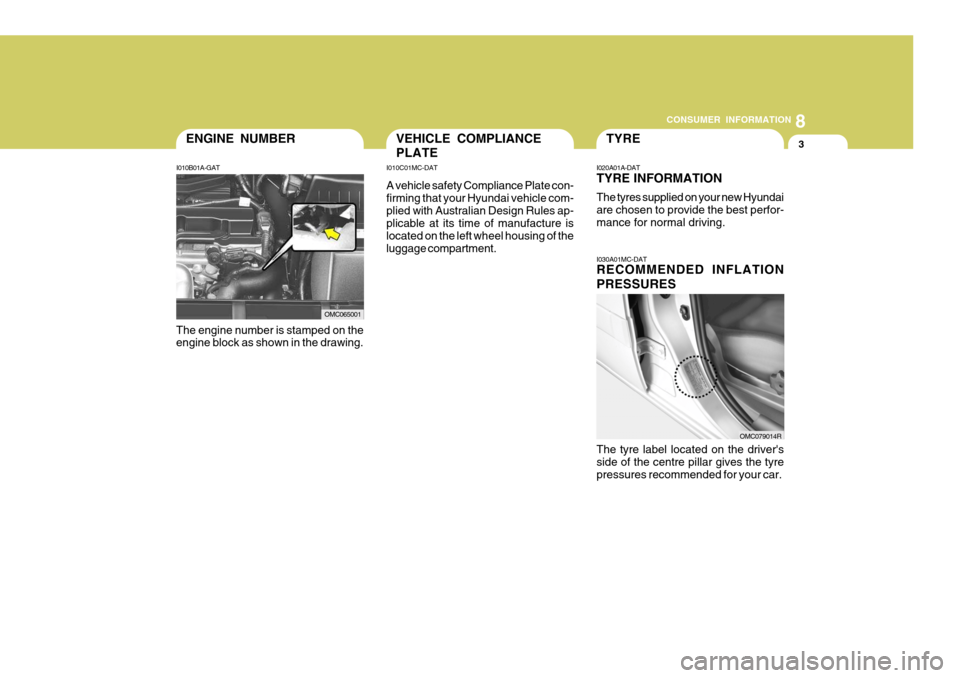
8
CONSUMER INFORMATION
3TYREVEHICLE COMPLIANCE PLATEENGINE NUMBER
I010B01A-GAT
The engine number is stamped on the engine block as shown in the drawing. I020A01A-DAT TYRE INFORMATION The tyres supplied on your new Hyundai are chosen to provide the best perfor-mance for normal driving.
I010C01MC-DAT A vehicle safety Compliance Plate con- firming that your Hyundai vehicle com-plied with Australian Design Rules ap- plicable at its time of manufacture is located on the left wheel housing of theluggage compartment.
I030A01MC-DAT RECOMMENDED INFLATION PRESSURES The tyre label located on the driver's side of the centre pillar gives the tyrepressures recommended for your car.
OMC065001
OMC079014R
Page 220 of 232
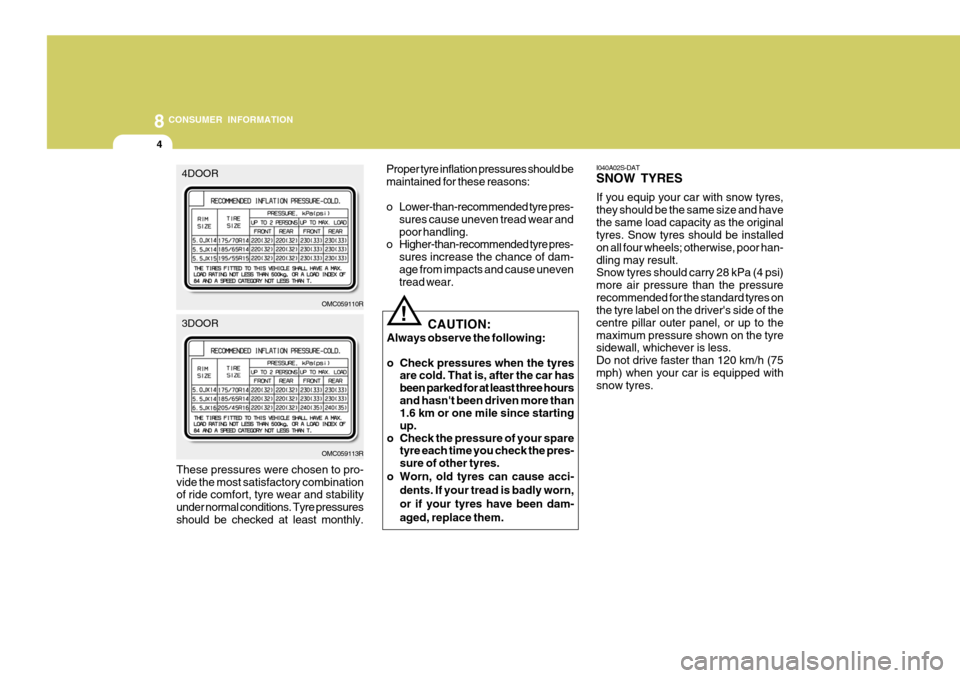
8CONSUMER INFORMATION
4
These pressures were chosen to pro- vide the most satisfactory combination of ride comfort, tyre wear and stability under normal conditions. Tyre pressuresshould be checked at least monthly. CAUTION:
Always observe the following:
o Check pressures when the tyres are cold. That is, after the car has been parked for at least three hoursand hasn't been driven more than 1.6 km or one mile since starting up.
o Check the pressure of your spare tyre each time you check the pres-sure of other tyres.
o Worn, old tyres can cause acci-
dents. If your tread is badly worn, or if your tyres have been dam-aged, replace them.
! I040A02S-DAT SNOW TYRES If you equip your car with snow tyres, they should be the same size and havethe same load capacity as the original tyres. Snow tyres should be installed on all four wheels; otherwise, poor han-dling may result. Snow tyres should carry 28 kPa (4 psi) more air pressure than the pressurerecommended for the standard tyres on the tyre label on the driver's side of the centre pillar outer panel, or up to themaximum pressure shown on the tyre sidewall, whichever is less. Do not drive faster than 120 km/h (75mph) when your car is equipped with snow tyres.
OMC059110R
OMC059113RProper tyre inflation pressures should be maintained for these reasons:
o Lower-than-recommended tyre pres-
sures cause uneven tread wear and poor handling.
o Higher-than-recommended tyre pres-
sures increase the chance of dam-age from impacts and cause uneven tread wear.
4DOOR 3DOOR